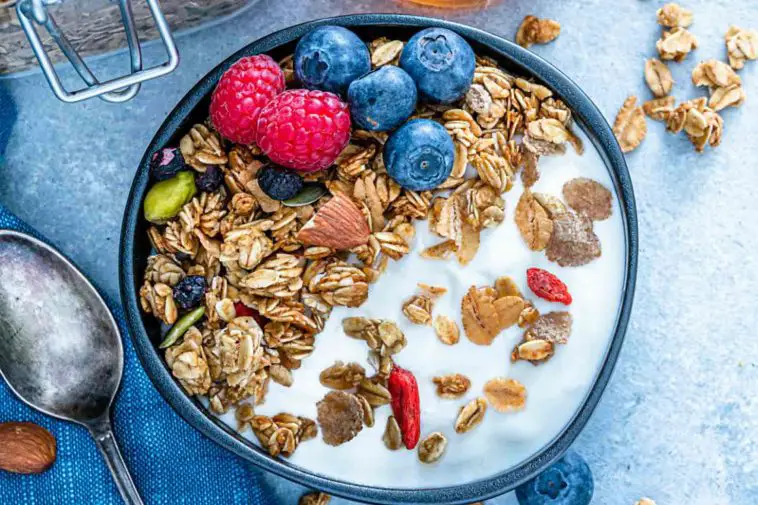Homemade granola has surged in popularity as a versatile and nutritious option for breakfast and snacks. Unlike store-bought versions, which often contain high levels of sugar and preservatives, homemade granola allows for complete control over the ingredients, ensuring a healthier and more personalized eating experience. Granola primarily consists of oats, a fantastic source of fiber, and can include a variety of nuts and seeds, each contributing its own set of nutrients and health benefits. This adaptability makes granola a favorite among health-conscious individuals and those who enjoy experimenting with different flavor combinations. Whether you’re looking for a quick breakfast, a portable snack, or a crunchy topping for your yogurt, homemade granola is an excellent choice that combines health, taste, and convenience.
Why Berries Make a Great Addition
Each type of berry brings its unique taste and set of nutrients, making your granola not just delicious but also incredibly healthy. Learn more about the nutritional benefits of berries.
Choosing the Right Ingredients
The foundation of any granola recipe lies in its ingredients, each bringing unique flavors and health benefits. Starting with oats, the most commonly used are rolled oats, known for their chewy texture and ability to hold together well during baking. They are a great source of soluble fiber, aiding in digestion and heart health. Steel-cut oats, although less common in granola due to their denser texture, can be used for a nuttier flavor and crunchier bite.
Dried berries like cranberries, blueberries, or raisins add a natural sweetness and chewy texture to the granola, along with antioxidants and vitamins. Nuts such as almonds, walnuts, or pecans contribute healthy fats, protein, and a satisfying crunch.
When it comes to sweeteners, honey and maple syrup are popular choices. Honey, with its antibacterial properties, adds a rich, floral sweetness and can help in soothing sore throats. Maple syrup, a vegan alternative, provides a subtle, earthy sweetness and contains minerals like manganese and zinc. Both are natural sweeteners and a healthier alternative to refined sugar, adding flavor while keeping the granola nutritious.
Step-by-Step Granola Making Process
Preparing the Dry Mix: Begin by mixing your choice of oats with a selection of dried berries and nuts in a large bowl. This combination forms the base of your granola, providing a balance of textures and flavors.
Creating the Wet Mixture: In a separate bowl, whisk together your chosen sweetener, such as honey or maple syrup, with a healthy oil like coconut or olive oil. This mixture will help in binding the granola ingredients together and achieving a golden color when baked.
Baking Tips for Perfect Crunchiness: Spread the combined wet and dry ingredients on a baking sheet lined with parchment paper. Bake in a preheated oven at a low temperature, around 300°F, to allow the granola to cook evenly without burning. Stir the mixture occasionally to ensure even baking and to achieve that perfect crunch. Once golden brown, remove from the oven and let it cool completely, as it will continue to crisp up.
Customization and Variations
Granola is incredibly versatile, allowing for numerous customizations and variations. You can add a variety of nuts and seeds like chia, flax, or pumpkin seeds for extra nutrition and texture. Incorporating other dried fruits such as apricots, figs, or coconut flakes can offer new flavors and sweetness levels.
For those with dietary restrictions, there are plenty of options. Use gluten-free oats for a gluten-free version of granola. For a vegan variant, replace honey with maple syrup or agave nectar. These simple swaps ensure that everyone can enjoy homemade granola regardless of their dietary preferences.
Creative Ways to Serve Granola
Granola is not just a breakfast item; its versatility makes it a delightful addition to various meals and snacks. One classic way to enjoy granola is by serving it with yogurt. The combination of creamy yogurt and crunchy granola creates a satisfying texture contrast. Adding a drizzle of honey or maple syrup can enhance the flavors further. Granola also pairs wonderfully with milk, acting as a healthier alternative to commercial cereals.
For a refreshing and nutritious option, try sprinkling granola over fresh fruits or blending it into smoothies for added texture. It also stands out as a standalone snack, perfect for those mid-day hunger pangs or as a post-workout nibble. The blend of oats, nuts, and berries provides a balanced mix of carbohydrates, protein, and healthy fats, making it an ideal snack.
Storing Homemade Granola
To maintain the freshness and crunch of homemade granola, proper storage is key. Always store granola in an airtight container to keep out moisture and preserve its crispness. A cool, dry place, such as a pantry or cupboard, is ideal for storage. Avoid exposure to heat or direct sunlight, as this can cause the granola to become stale or rancid, especially if it contains nuts.
Frequently Asked Questions
- Can I use frozen berries in granola? Yes, but it’s recommended to first dry or dehydrate frozen berries to avoid adding moisture to the granola. Dried berries work best in maintaining the crunchy texture of the granola.
- How long does homemade granola last? When stored properly in an airtight container, homemade granola can last for up to two weeks. Ensure it’s kept in a cool, dry place to maintain its freshness and crunchiness.
- Are there any nut-free options for granola? Absolutely! For a nut-free granola, simply omit the nuts and replace them with seeds like pumpkin, sunflower, or flaxseeds. You can also add more dried fruits or oats to compensate for the bulk and texture that nuts provide. This makes the granola suitable for those with nut allergies or preferences.
In conclusion, homemade granola with berries is not just a delicious and versatile breakfast option but also a nutritious choice that can be tailored to meet various dietary needs. By choosing the right ingredients and adding a personal touch, you can create a granola that is both satisfying and healthy.






Comments
Loading…